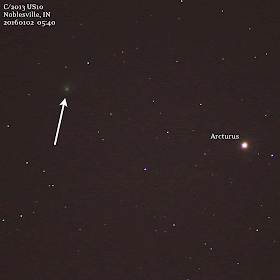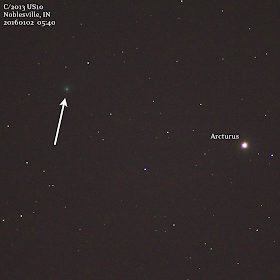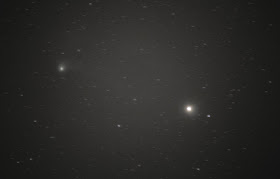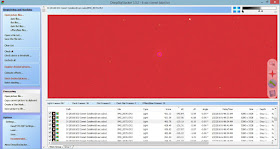I did a rushed setup and got some pretty poor alignment, meaning I could only take up to 6 second exposures without star trails. I was feeling lazy so I figured 6 seconds was good enough and I didn't want to re-align everything. I was also battling the pre-dawn twilight, which would ruin my session in a couple hours.
This YouTube video shows a timelapse of my setup, getting the Canon T5i on the Orion EQ mount. The Orion EQ-1 mount has an optional motorized attachment that will turn the camera/telescope to compensate for the rotation of the Earth. The motor does not track or lock on to anything, it just tries to turn at a constant rate. While this might be good for keeping your target in the field of view longer, it's not very smooth or precise. It's much better than a fixed tripod, however.
Notice the amount of drift in the timelapse video at the end. My alignment was not great, but that should result in a constant drift in a single direction - not the shaking up and down motion we see. It looks like small variations in the motor speed are causing the mount to lag or speed up.
The sequence at the end is 239 frames, each 6 second exposures at ISO 3200, f/5.6, 300mm with Canon T5i on January 2, 2016. If you look closely you can see the small fuzzy comet move slowly to the left relative to the star below it.
Comet photos with DSLR are tricky, especially with a very basic mount like this or even on a fixed tripod. Sometimes I get good results with stacking, and sometimes I like single frames better. I was really hoping to get some of this comet's tail, like I did with comet Lovejoy last year, but 6 seconds was just not enough.
While taking over 230 individual photos, each at 6 seconds long, the comet moved a noticeable amount. This thing is moving quick! It becomes more obvious when you look at the first and last frame I took that morning. Here is an animated GIF showing the earliest and latest frame from my stack to show the change in position.
 |
| Animation of 2 single frames taken with Canon T5i each at 6 sec, ISO 3200, f/5.6, 300mm |
 |
| Single frame from the GIF animation above in large .png format to show detail |
In Deep Sky Stacker, you literally have to go in and click on the comet in every single light frame to teach the program where the comet is. This maybe isn't so bad if you have 6x 5 minutes exposures or something, but I had over 200x 6 second exposures. Ugh! I gave it the ol' college try to see what it would do, and I was underwhelmed. After about 2 hours of pin-pointing the comet in sub frames and another 2 hours of stacking, the image below is what I got out of it.
 |
| Stack of 213 light frames, 38 dark, 25 bias, ISO 3200, f/5.6, 300mm, 6 sec (no flat frames) |
 |
| Tagging the comet frame by frame in Deep Sky Stacker |
Here is another process with flat frames - do I see a hint of a blobby tail coming off to the right or is that my imagination? Honestly, I like the look of the single frames better. The stars are around and the comet has color. I just should have spent more time on the set up and gotten longer exposures!!
 |
| Same process as above but with flat frames to remove the hot spot in the middle |
No comments:
Post a Comment